Hastings is one of the best places on the East Sussex coast to sample fresh seafood. A walk along its seafront also reveals historically fascinating buildings, an award-winning new pier, the iconic Jerwood Gallery and an Old Town full of independently run venues in which to eat, drink and shop.
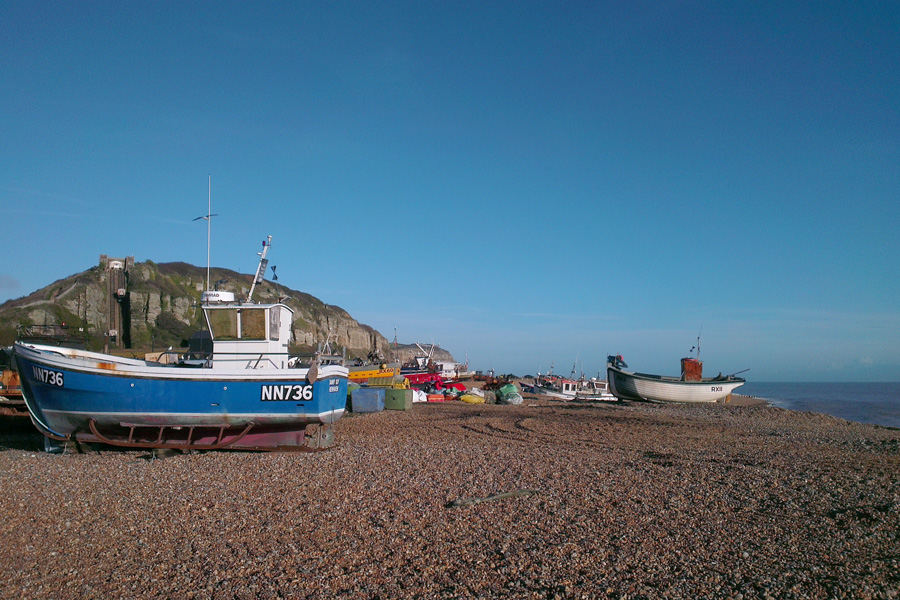
Fishing boats on Hastings beach (Photo: Rebecca Steel)
On the surface, Hastings could easily be dismissed as just another British seaside resort that has already seen its heyday. Yet if you scratch beneath you will find many admirable qualities, which are attracting an increasingly young and trendy crowd. The town has an incredible history, thrives on creativity and maintains a pride in its local produce, especially where fish and seafood are concerned. It is easy to spend a whole day exploring the sights of the Old Town, including its historic houses, churches, pubs, little museums and independent shops. With direct trains from London, it is a straightforward escape to fill your lungs with sea air. Others come from further afield, as the town benefits from its proximity to the Port of Dover and a train link with Ashford, which connects with the Eurostar.
Historical Marvels
Most visitors will have heard of the Battle of Hastings in 1066, when the Normans, led by William the Conqueror, defeated King Harold II and his army. Yet the name of this hugely significant event is misleading because the conflict took place seven miles to the north west of Hastings. Nevertheless, you can still walk among the ruins of Hastings Castle, high upon the cliff top, which stands as a reminder of the dominance of the Norman Conquest in this area and beyond.
A rich maritime heritage has earned Hastings further attention in the history books. During Medieval times it was one of five original Cinque Ports, which provided the Crown with ships and men in return for special privileges. Over the centuries it has also been a prime location for smugglers who excavated caves from the sandstone cliffs. Smugglers Adventure, an attraction popular with children, brings to life these tunnels and dwellings in St Clements Caves under the West Hill.
Today the shores of Hastings are a hive of activity for the fishing industry. Witness this first-hand by watching the daily catch being unloaded by Europe’s largest beach-launched fishing fleet. Due to the town lacking a harbour, the boats are dragged and winched along the shingle beach. Visitors can wander alongside the tall black huts, or ‘net shops’, which were once used to dry nets and equipment, but are now preserved as iconic tributes to this centuries-old fishing tradition.
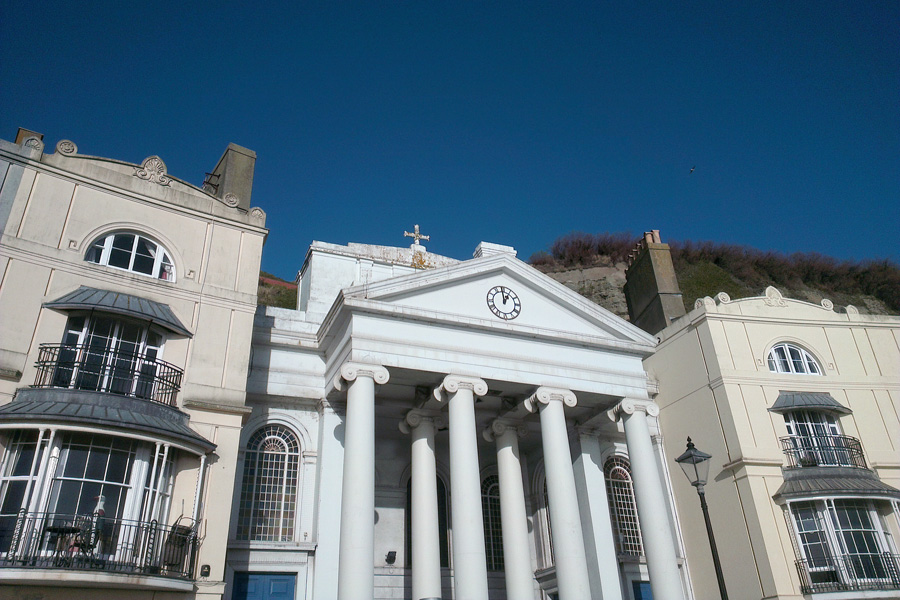
St Mary in the Castle (Photo: Rebecca Steel)
Resort Heyday
Hastings started to attract the crowds in the late 1700s when the wealthier classes sought the health benefits of the seawater and local springs. This led to the creation of buildings like St Mary in the Castle; a Neo-Classical fronted church, which formed part of the Regency-style Pelham Crescent on the seafront. Its large auditorium was carved into the cliff face and can still be visited today as part of an arts centre used for theatre, opera, film screenings and live music.
With its popularity as a seaside resort growing, Hastings expanded west from the Old Town, eventually connecting up with the new settlement of St Leonards-on-Sea. A population explosion in the 19th century led to the formation of a town more akin to its present-day size. This was aided by the arrival of the railway, especially two lines to London. Funicular railways also sprang up, making it possible to move up and down its steep cliffs. The West Hill and East Hill Lifts on these tracks are still in operation, allowing scenic vistas to be enjoyed on a clear day.
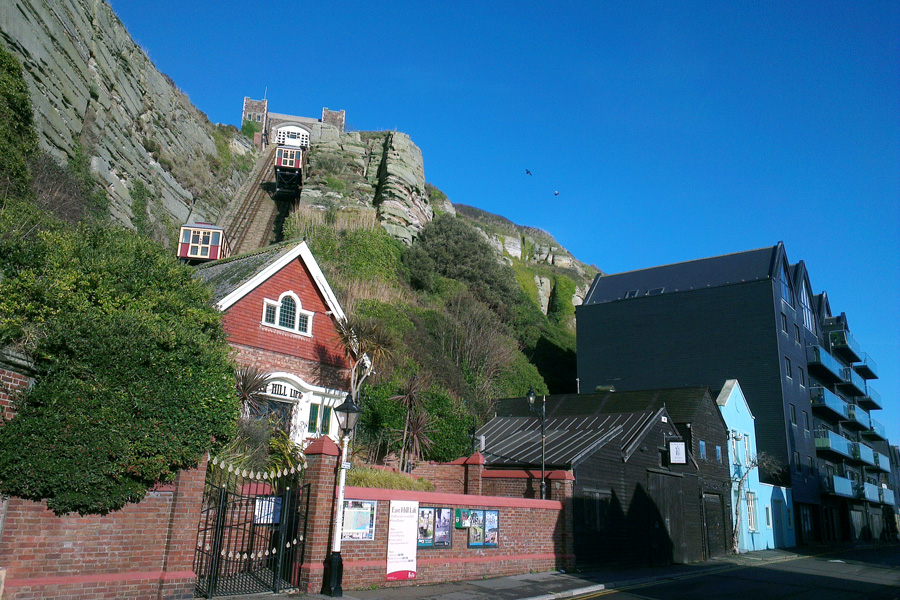
East Hill Lift (Photo: Rebecca Steel)
Sadly the town’s boom years weren’t to last. As the 20th century progressed, traditional British seaside destinations became less fashionable. Holidaymakers started taking their vacations abroad, contributing to the economic decline of many resorts like Hastings. Since the 1930s there have been numerous attempts at reviving the fortunes of the town, which is still home to a relatively poor coastal community. Yet these new projects and building schemes have not always been successful, sparking much controversy along the way.
Town Revival
The last few decades have brought about a renewed interest in the regeneration of the town. In 2016 Hastings Pier reopened; six years after a fire had mostly destroyed its original Victorian structure. The new award-winning design juts into the sea with little obstruction, making you feel like you are walking on water as you stroll across it. The pier also uses reclaimed wood from its predecessor in its sun-drenched Upper Deck café and minimalist visitor centre; a space used for education, exhibitions and events.
The opening of the Jerwood Gallery in 2012 brought one of the biggest cultural boosts for the town. Hastings had become renowned for attracting creative types; therefore it seems a fitting site for a brand new beachside art gallery. The venue showcases a modern and contemporary British art collection in a prime location next to the Old Town, known as The Stade. It also hosts critically acclaimed exhibitions in a building that famously affords picturesque views of the fishing boats.
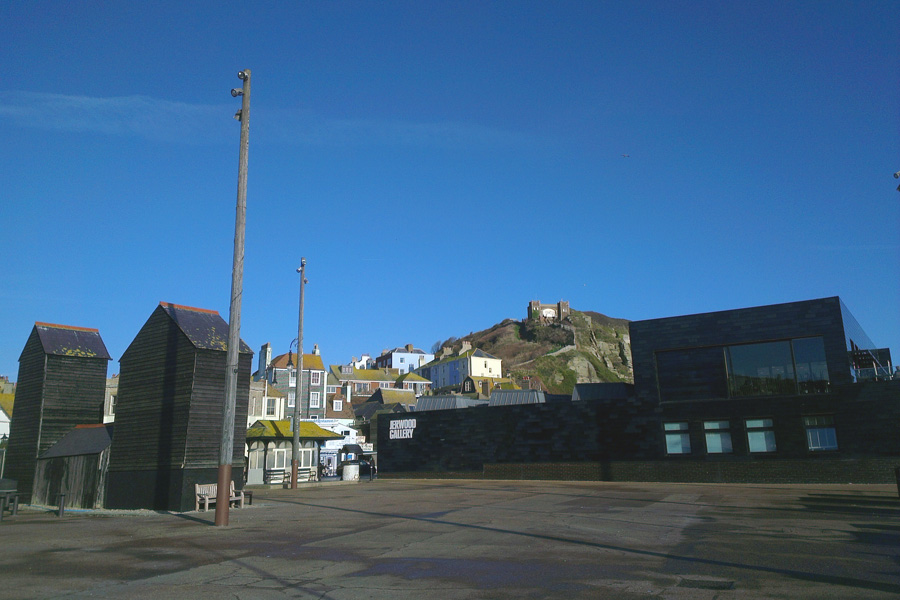
Jerwood Gallery (Photo: Rebecca Steel)
For an extra dose of culture you can visit Hastings during one of its many festivals and events that take place throughout the year. Creative talent goes on display in the Coastal Currents arts celebration and during music festivals like Fat Tuesday, which combines several days of live music and Mardi Gras costumes. The Seafood and Wine Festival, championing local produce, also draws a large crowd. Some events are decidedly more traditional, such as the four-day Jack in the Green Festival of Morris Dancing, featuring May Day dancers, drummers and parading characters covered in greenery. Perhaps the most breath-taking event is Hastings Bonfire Night, which continues a Sussex custom of staging processions followed by pyrotechnic extravaganzas.
Accommodation
Those seeking an alternative to the standard seaside budget hotel need look no further than Le Château Japonais (2 Linton Road). Blending French and Japanese influences, rooms come with deep-bath Jacuzzis and high-tech Japanese toilets. The outdoor hot pool is understandably popular with guests who like to relax while gazing up at the stars. This family-run B&B benefits from a quiet location away from the seafront, but within easy reach of the town centre and railway station.
The five-star White House Hotel (12 Godwin Road) offers a peaceful retreat high above the Old Town and within close proximity of a 400-acre country park. Equally pleasing to the eye are the hotel’s landscaped grounds featuring exotic plants, ponds, lawns, terraces and an outdoor swimming pool. Guests can stay in one of five en-suite bedrooms, or groups can book the whole of this elegant Victorian House for their exclusive use.
Restaurants, Bars and Cafés
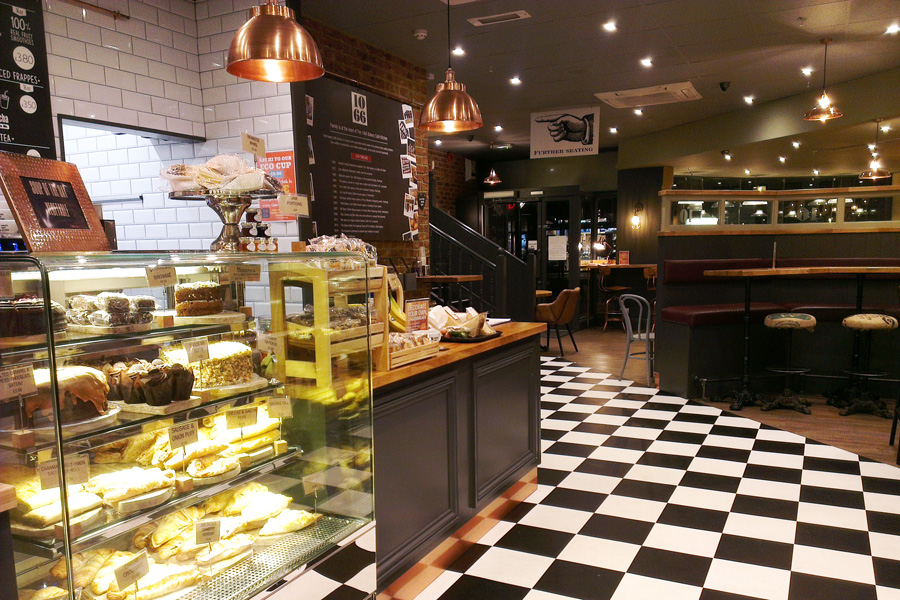
1066 Bakery (Photo: Rebecca Steel)
Two branches of 1066 Bakery (5 Station Road/ 36 Priory Meadow) are conveniently placed for a quick lunch or coffee in the heart of Hastings. Established in 1950, the bakery prides itself on using local ingredients, sourcing most of its products from businesses within a 30-mile radius. Furthermore, award winning baked goods, breakfast specials and fresh salads can be consumed inside their café in an old double decker bus parked in St Leonards.
The laid-back feel of Hanushka Coffee House (28 George Street) can be quite appealing after a day spent sightseeing. The walls are crammed full of books to browse and the window seats provide a perfect place to watch the passers-by on one of the Old Town’s busiest streets. Light lunches, ice cream and cakes are also served alongside a decent coffee in this friendly café.
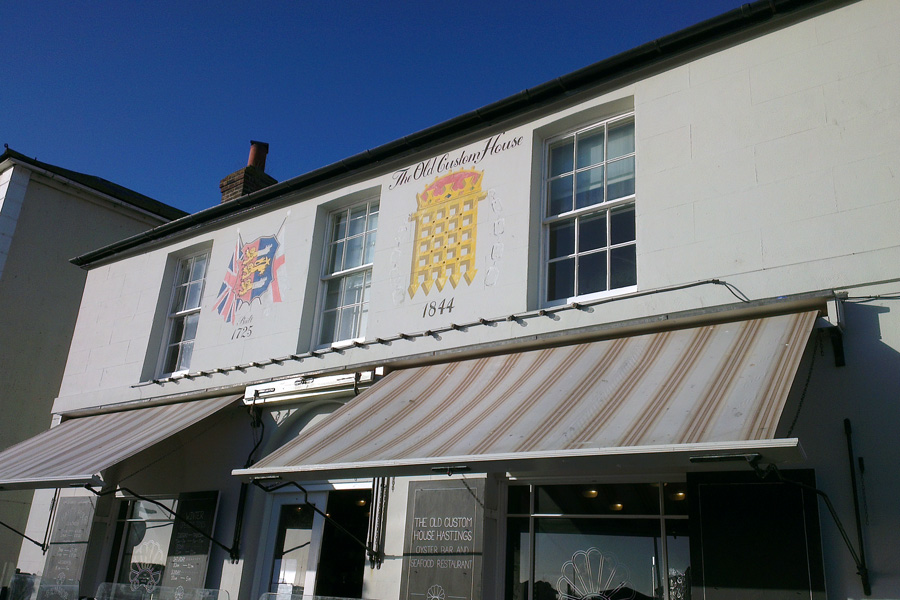
The Old Custom House (Photo: Rebecca Steel)
When it comes to eating out in Hastings, the town is unsurprisingly home to a plethora of venues serving local fish and seafood, but few offer the oyster bar experience of The Old Custom House (19 East Parade). Launched by the locally based St Clements restaurant, it provides a seafront alternative to their a la carte venue in St Leonards. Here diners can enjoy oysters, seafood platters or tapas-style plates accompanied by a well-selected drinks list.
Local artwork adorns the walls of Dragon Bar (71 George Street), which has a friendly atmosphere and a busy vibe, especially when DJs play there at the weekends. The owners opened the premises in 2005 following their success with a bar of the same name in Shoreditch, London. Restaurant-quality seasonally inspired meals are freshly prepared on the premises. Lunch and evening menus comprise of dishes like fisherman’s pie, treacle-boiled gammon, vegetarian burgers and thin crust pizzas made-to-order.
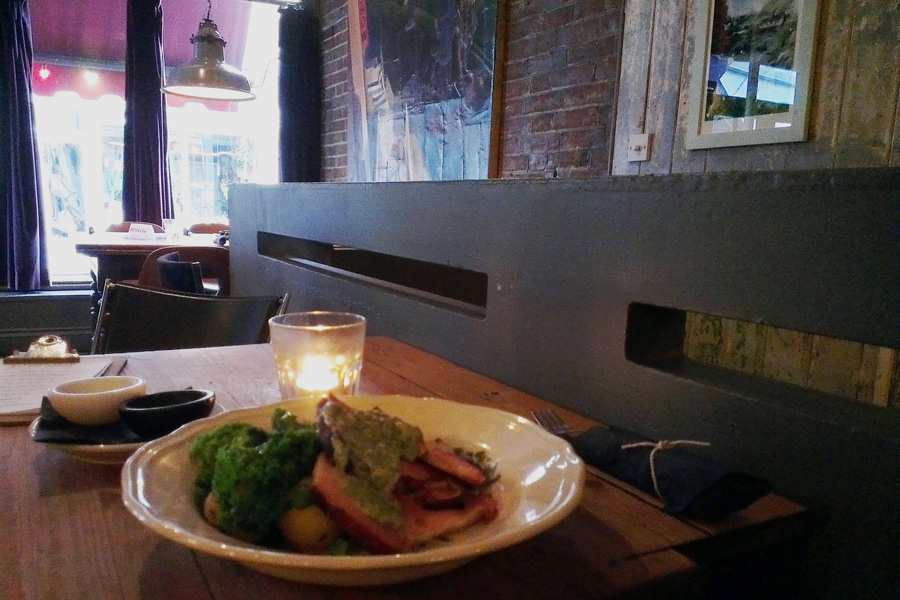
Dragon Bar (Photo: Rebecca Steel)
On the ground floor of The Printworks (14 Claremont) is a trendy bar that hosts special events on Thursday to Saturday evenings, which can be anything from live music to literature and theatrical performances. Moreover, this five-storey Victorian building offers much more than a bar, with each floor serving a different purpose, including homeware store, design studio, creative hub and B&B. Effortlessly stylish interiors are inspired by its former use as a local newspaper office and historical roots in The America Ground quarter of Hastings.
Shopping
The Old Town, historically at the centre of Hastings, is a popular shopping destination for those in search of independent retailers. An enticing selection of specialist stores and antique shops spill out from its narrow streets and passages, known locally as ‘twittens’.
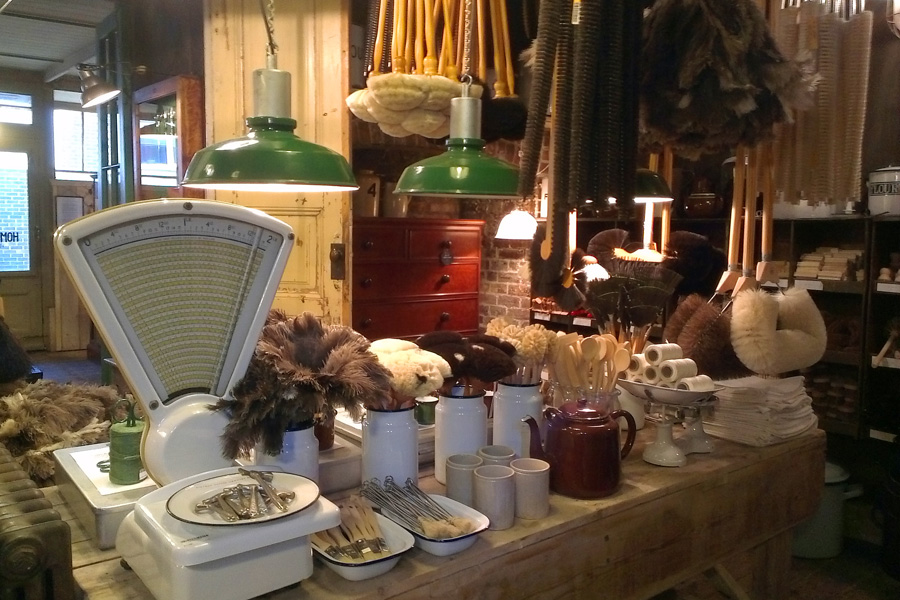
A G Hendy & Co Homestore (Photo: Rebecca Steel)
A G Hendy & Co Homestore (36 High Street) displays homeware from a time when pantries and sculleries were still in existence. Goods are laid out on antique furniture across several levels of a quirky house with stripped-back floorboards and old-fashioned bathrooms and fireplaces. Mixing new and vintage, its ranges reflect the revival of products like enamelware and non-plastic brushes for the home. This enterprising business also runs a cookery school and small restaurant, which serves lunches during summer weekends.
In the middle of the High Street sits the sophisticated delicatessen Penbuckles (50 High Street). A favourite with the locals, they sell a range of artisan treats, specialising in international wines and cheeses, including regional favourites. You can also sample delicious cakes, pastries, pies and deep-filled sandwiches along with a cup of Monmouth Coffee in their tasting room.
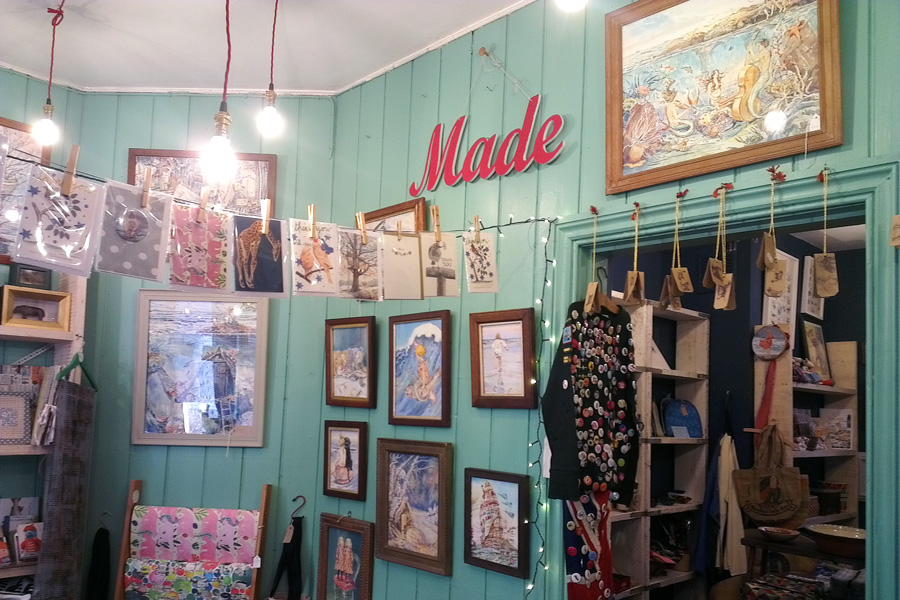
Made in Hastings (Photo: Rebecca Steel)
Made in Hastings (82 High Street) is run by five women who are keen to support local creativity by stocking products made by artists and craftspeople in the Hastings area. A cavern full of treasures; the shop displays are brimming with hand-made souvenirs and gifts, such as stationery, jewellery, scarves and products for the home. A distinctly nautical theme is present among its many wares, especially in picture book-style seaside prints by artist, Claire Fletcher and ceramics decorated in a palette of blues, greys and greens by potter Judith Rowe.
Butler’s Emporium (70 George Street) is one of the best-loved shops in the Old Town. Despite stocking mostly new products, the layout lends itself to that of an antiques shop, with a few relics from the past hiding among the displays. Gifts from around the world are sold here, such as fragrant soaps from Provence and Fair Trade slippers made in Nepal. Several ranges are also from Sussex-based companies, like Parkminster Products, who are well known for their hand-poured candles, which come in a range of unusual scents.

Voodoo Sirens (Photo: Rebecca Steel)
Voodoo Sirens (60 George Street) has become something of a mecca for vintage clothing enthusiasts. Specialising mostly in women’s garments from the 1940s to the 1960s, several genuine articles are on sale alongside vintage reproductions like patterned dresses and shaped trousers. Colourful handbags, shoes and accessories add a little extra glamour to the experience. In addition, the increasing demand for men’s clothing has led to the creation of a ‘man cave’ at the back of the shop.